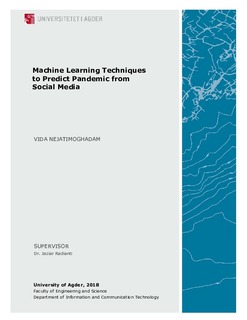| dc.description.abstract | In recent years, there has been a particular focus on improving public
health through the means of prediction and preparedness of pandemic diseases.
Early detection, prediction, and analysis of disease outbreaks allow
the authority agencies to mitigate the side effects of Pandemic and immune
the people. Nowadays, social media such as Twitter or Facebook play a vital
role in the crisis situation. By means of social media, people from all over
the world can be aware of the recent pandemic outbreaks. In fact, the mainstream
adoption of social media in people daily life has caused a paradigm
shift in how people communicate, create, cooperate, and use information
during a crisis. Moreover, by analyzing data, which broad-casted during
a crisis, the relevant health organizations or agents can discover much useful
information.
On the other side, the volume and velocity of messages or tweets during
crises today tend to be extremely high and make it hard for discerning and
taking an actions. Therefore, machine-learning techniques can be used to
help analyzing this big flow of messages. They are the useful way to discovering
the knowledge from big data. Various methods and machine learning
algorithms have been proposed and applied in various cases.
In this work, we adopted data analysis and predictive techniques. Several
features from tweets have been extracted and data is modeled by binary classification
for pandemic prediction. Three different predictive models (Support
Vector Machine, Decision Tree, and Naive Bayes) have been conducted
in order to pandemic prediction. Our experimental results illustrate that
SVM technique outperforms other techniques. However, there is no global
best predictive model and it depends on various parameters such as dataset,
configuration, etc. | nb_NO |

